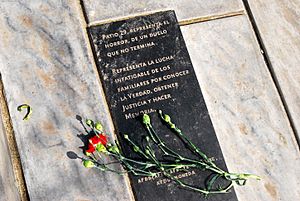Patio 29 facts for kids
Patio 29 (which means Yard 29 in Spanish) is a common grave site located in the Santiago General Cemetery in Chile. It was used to secretly bury people who were taken by the government, especially during the time of the 1973 Chilean coup d'état when Augusto Pinochet was in power. Many of these people were "disappeared" and their families did not know what happened to them.
Patio 29 was the largest secret burial site used by Pinochet's military government. Bodies were buried there without names or proper records in the 1970s. People only found out about it because of a secret tip. When democracy returned to Chile in 1990, a big effort began to dig up the graves and identify the bodies. By 2006, 126 bodies were found. Most of these victims were identified, but later DNA tests showed some mistakes. A new system for identifying bodies started in 2007.
In 2006, Patio 29 became the first cemetery in Chile to be named a protected national monument. It is now an important symbol for human rights and for remembering those who disappeared during the 1973 coup. Many marches against the coup end at this site every year.
Contents
What Happened at Patio 29?
In 1973, a military coup took over the government in Chile. Augusto Pinochet, the army's leader, became the head of the country. His military government stopped people from disagreeing with them. Many people were killed or "disappeared" during this time, especially in the first few months after the coup.
In 1979, a human rights group from the Catholic Church, called the Vicariate of Solidarity, learned about secret burials in Patio 29. This led to an investigation. It was found that Patio 29 had been used to secretly bury the bodies of people who had been executed or kidnapped between 1970 and 1980. Many of these were victims from the 1973 coup.
After military rule ended and democracy returned to Chile in 1990, finding out the truth about human rights problems became very important. A special group, the National Commission for Truth and Reconciliation, was set up. In 1991, their report named many victims who had disappeared and were believed to be buried in Patio 29. This site was the biggest of about twelve secret mass graves found from Pinochet's time.
Finding the Bodies
In 1991, judges ordered that the graves in Patio 29 be dug up and the bodies identified. Most of the 105 bodies found in 1991 had been shot or beaten. Some were missing body parts or were tied with wire. Some victims were as young as 13 years old. In some coffins, there was more than one body. Pinochet, who was still the army chief, made a comment about saving space by stacking bodies, which caused a lot of anger.
Records from the Catholic Church and autopsy reports were used to identify the bodies and return them to their families. By 2006, 126 bodies were found. Most were identified by 1998. However, in 2005, DNA tests showed that many identifications were wrong or uncertain. Because of this, a new DNA database was started in 2007 to correctly identify the victims.
Becoming a National Monument
On July 13, 2006, Chile's National Monuments Council declared Patio 29 a National Monument. They chose the site because it showed how the military government tried to hide the bodies and identities of the disappeared. At the ceremony, Patio 29 was called a symbol of Chile's difficult history and a place to learn about human rights. As a national monument, the government now helps to protect and maintain the site. It was the first cemetery in Chile to become a national monument.
In 2008, a design contest was held to improve Patio 29. The winning plan included a music plaza with seven copper columns. This plaza connects Patio 29 with the tomb of Víctor Jara, a famous singer who was also a victim of the 1973 coup.
What Does Patio 29 Look Like?
Patio 29 is a section within the Santiago General Cemetery. It is surrounded by Mexico Avenue, O'Higgins Avenue, Copihues Street, and Maitenes Street. Even though the cemetery changed its numbering system in 1987, this section is still known as Patio 29.
The section has 105 graves, but many of them held more than one person. The graves still have their old, rusty iron crosses as headstones. These crosses often show the burial date and "NN," which means "no name." Most of the dates are from the last few months of 1973. No new burials have happened at this site since then. The tomb of folksinger Víctor Jara, a well-known victim of Pinochet's 1973 coup, is located across from Patio 29.
A special walking path for visitors, called the "popular route," goes through the cemetery. It connects the Memorial for the Disappeared at the cemetery's entrance to Víctor Jara's tomb near Patio 29. A sign at the Patio 29 memorial explains that it is an important place for remembering the human rights problems that happened between 1973 and 1990. It reminds people that the site was used to hide the bodies and identities of those who were taken and killed during the military government. The yearly protests against the September 11, 1973 coup start at the presidential palace and end here at the General Cemetery.
How Patio 29 Influenced Culture
The discoveries at Patio 29 led to two documentaries: Patio 29: Histories of Silence and Fernando ha vuelto. The second film tells the story of finding Fernando Olivares Mori's body, his burial, and an interview with his wife after the DNA test doubts came out.
Patio 29 has become a strong symbol for remembering the past and for human rights. It is part of a government program called "symbolic reparation," which aims to help heal the wounds of the past by honoring the victims and their families.
See also
 In Spanish: Patio 29 para niños
In Spanish: Patio 29 para niños



